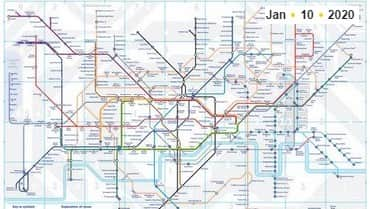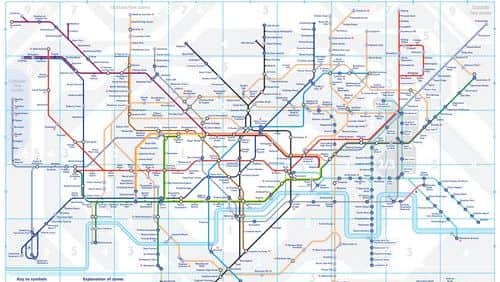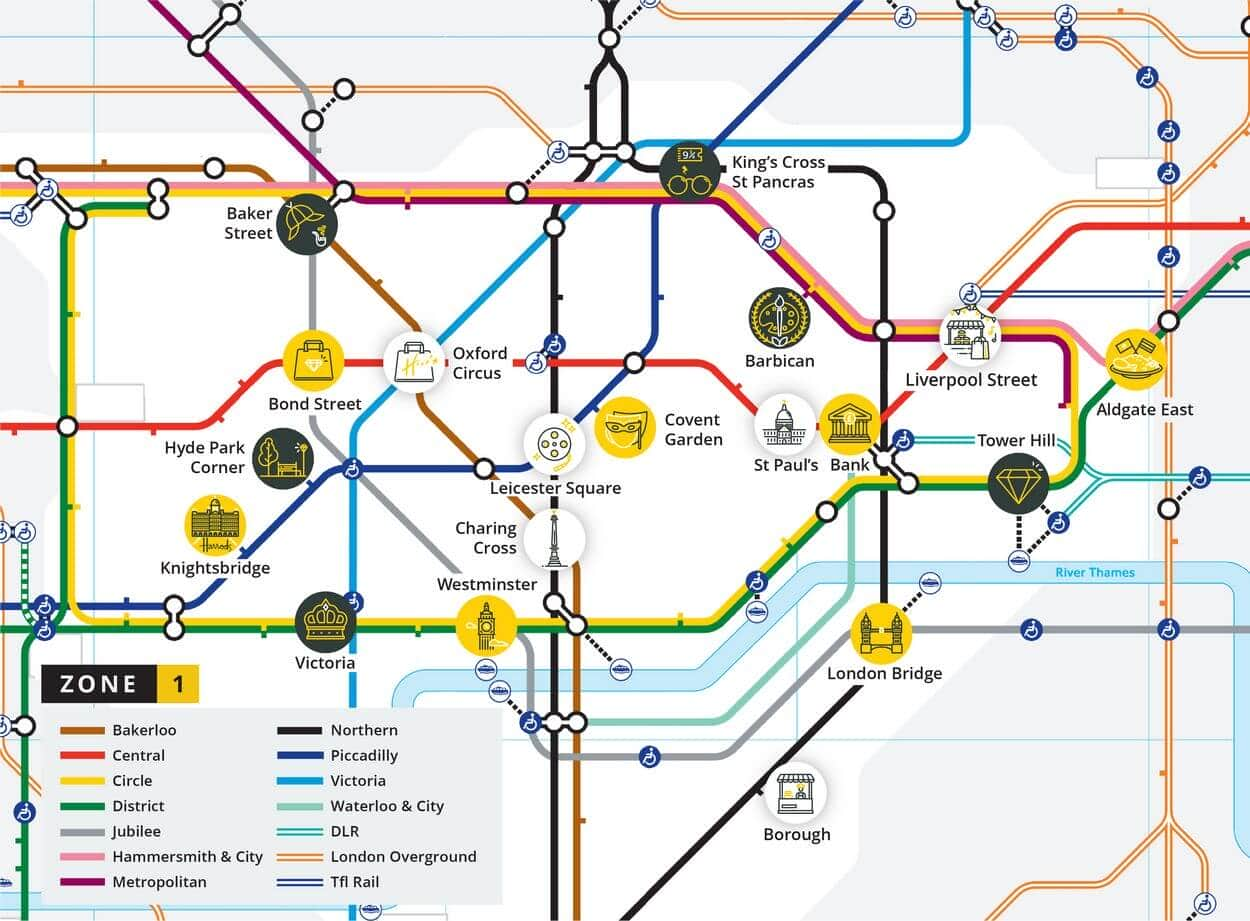 Planning a visit to London but need some help getting around all the famous landmarks and must-see places while you’re in town? Well, our team of London Taxi Drivers share their wisdom and handy facts to help you decipher London’s tube map and all the top London attractions found at the centre of it. After all, who is better to explain it than those with all The Knowledge?
Planning a visit to London but need some help getting around all the famous landmarks and must-see places while you’re in town? Well, our team of London Taxi Drivers share their wisdom and handy facts to help you decipher London’s tube map and all the top London attractions found at the centre of it. After all, who is better to explain it than those with all The Knowledge?
London tube map – a cabbie’s run down
It may be the oldest underground railway (referred to by Londoners as the tube) in the world, but it is still one of the easiest ways to get around London. At first glance, the London tube map can seem a little overwhelming probably because the tube map we use today was designed by electrician Harry Beck who based the map on an electrical circuit – the stations being the switches. However, the 1.3 billion people travelling on the London tube every year are living proof that it’s easy to use when you know how. Before we guide you through the map, you’ll need to get your hands on one so if you haven’t already downloaded the Tube Map app then you can either find a tube map online or pick a paper copy up from your nearest tube station.
Tube line colours
Not all the tube lines are underground in fact, only 45% of the network is underground. Each coloured line represents a transport line. For example:
- The solid coloured lines represent the underground lines
- The white and orange mix lines represent the overground train lines.
- The blue and white mix lines represent the Docklands Light Railway (DLR), which is a monorail
- The green and white mix lines represent the London trams
If a line has more than one colour i.e. The District and Circle lines, it means that multiple train lines use the same track and stations. Be extra careful when travelling on these lines to get on the right train on the right line.
- The District Line has the most stations on the underground network.
- The Waterloo & City Line only has two stations.
- The London Underground first opened on the 10th January 1863 as the oldest section of underground railway in the world, running between Paddington (then known as Bishop’s Road) and Farringdon on what is now part of the Circle, Hammersmith & City, and Metropolitan
Tube stations
Each station on the map is named and stations with this symbol are stations where you are able to change lines. Once you know where you want to go and which station is closest, you can work out your most direct route.
London travel zones and tickets
London is divided into 1–9 zones. Central London is zone 1, zone 2 is the ring around zone 1, zone 3 is the ring around 2 and so on. You can see the zones on the tube map. The zones are marked in either white or grey. It’s important to be aware of London’s transport zones and to check what zone a station is in as ticket prices for Travelcards or the money deducted from a pay as you go Oyster Card can vary considerably according to how many zones you travel through so make sure you purchase the right ticket for your visit to London. Most people in London tend to use an Oyster Card or a contactless payment card but weigh up the options to see what is best for your itinerary. The zones do not apply to bus travel. You can travel by bus all over London (zones 1–6) with any Travelcard.
Top London attractions found in tube map zone 1
Most visitors to London tend to stick around zone 1 as this is where most of London’s popular tourist attractions are housed. Here is our handy map showing which tube station is needed for some of the best London tourist spots:
- Many stations have important historical associations and many of the early stations were tiled in distinctive schemes so that anyone that couldn’t read would recognise the tile design and know which station they were at.
- During the Second World War many tube stations were used as air raid shelters.
- Liverpool Street station is said to be built on a mass grave used during The Great Plague of 1665. It is also on the site of the early Bethlem Hospital.
- West Hampstead station was originally called West End but was confusing for people heading to the shopping district known as the West End.
| Underground station | Attractions |
| Victoria | Buckingham Palace - Home of the Queen, guarded by the Queens Guards in their famous Bearskin hats. |
| Charing Cross | Trafalgar Square - Home of Nelson's Column and The National Gallery. |
| Leicester Square | This is where film premieres take place, some great night life and access to China town. |
| Covent Garden | Home of London's Theatre land, the Royal Opera House and The London Transport Museum. |
| Tower Hill | See the Crown Jewels, take a legendary Yeoman Warden Tour and meet the ravens at The Tower of London. |
| Westminster | Big Ben and the Houses of Parliament. |
| Bank | Visit the central bank of the UK on Threadneedle Street. At the Bank of England you will be able to see where all banknotes are issued, where government funds are raised, where the country's foreign exchange reserves are managed, and where the interest rates are set. You can even hold a bar of gold in the Bank of England Museum. |
| London Bridge | If you want to visit the site of the oldest crossing on of the River Thames on record then you need to visit London Bridge. London Bridge has existed in one form or another for nearly 2,000 years now. |
| Borough | Visit the hustle and bustle of London's most renowned food and drink market. |
| King's Cross St. Pancras | Walk in the footsteps of the young wizard and visit Platform 9¾ and the Harry Potter shop at London's Kings Cross St Pancras Station. You can also pick up a train from here to the Harry Potter Warner Bros. Studio Tour. There is also a choice of 5 tube stations you can depart for Kings Cross St Pancras: Circle, Piccadilly, Hammersmith & City, Northern and Metropolitan lines. |
| Bond Street | Get ready to shop! Both exits of this station will lead onto Oxford Street. The difference between Oxford Street and Bond Street is mainly that Bond Street has more high end stores and boutiques and Oxford Street is queen of the high street chains. |
| Oxford Circus | As well as shopping this is the closest station to Hamleys - the biggest and finest toy shop in the world. |
| Hyde Park Corner | If you need a break from City life head to Hyde Park - the largest green space in central London and one of the 8 royal parks. The 5* Dorchester Hotel is just around the corner too if you would like to experience a traditional English Afternoon Tea. |
| Knightsbridge | The home of the world's most famous department store - Harrods. |
| St Pauls | Experience awe-inspiring interior, rich history, incredible acoustics and the finest views over London with a visit to St Paul's Cathedral. |
| Liverpool Street | Alight here for Spitalfields market - open every day with plenty of restaurants, bakeries, fashion, art, music and events. |
| Aldgate East | The best stop if you want to trial the amazing Indian and Bangladeshi restaurants along Brick Lane. Great bars and coffee places too. |
| Baker Street | 221B Baker Street is the London address of the fictional detective Sherlock Holmes, created by author Sir Arthur Conan Doyle. The Sherlock Holmes Museum will satisfy all fans. You can also visit some other celebrities from this tube stop at Madame Tussauds. Madame Tussauds and its famous waxworks is one of the most popular tourist attractions in the city. |
| Barbican | Home of the world-class arts and learning centre. The Barbican Centre hosts different types of cultural events such as concerts, film screenings and art exhibitions. More impressively, inside is a library, three restaurants and a conservatory. These features make The Barbican Centre the largest of its kind in Europe. |
How to ride the tube in London
When you know where you want to go, found your nearest tube station and bought your Oyster Card (or equivalent) you are ready to board the tube! As you approach the barrier, tap your Oyster Card on the yellow reader and the gate will open so you can enter the tube line. Follow the signs to the line you’re looking for and make sure you find the correct eastbound or westbound service (this will be made clear on the signposting within the station. Trains are very regular and the digital screen on the platform will tell you how long you will have to wait for the next train (usually two or three minutes). As the train approaches, check the front of the train to see its final destination. This will tell you if it’s the right train for you.
When the train arrives, the general rule of thumb is that passengers on the platform allow the passengers to leave the train before boarding. Remember to “mind the gap” when you jump on board!
Top tip…when you reach your destination, remember to ‘tap out’ by tapping your Oyster Card on the yellow reader when you leave the station. You need to do this even if the gate is open to make sure you pay the correct fare price and do not get overcharged.
- During the 1930s people were not alone in riding the tube, London’s letters and parcels travelled on the Mail Rail which you can now experience at The Postal Museum near London’s Kings Cross.
- 1890 saw the first electric tube which ran between King William Street and Stockwell.
- The average speed on the 250 miles of underground track is 20.5 miles per hour.
Hopefully now you are feeling better equipped with the knowledge you need to board the London tube network. However, if you’d rather a private, less chaotic, stress free tour of England’s capital city then one of our expert London Taxi Guides will happily oblige. Check out our latest taxi tours or contact us to customise your own.





